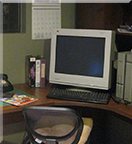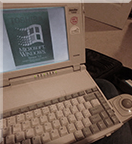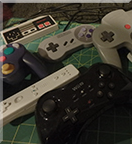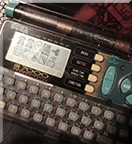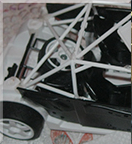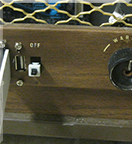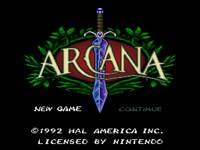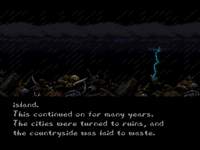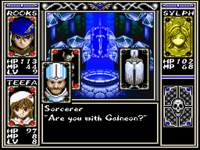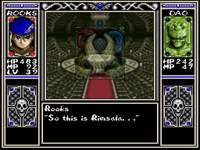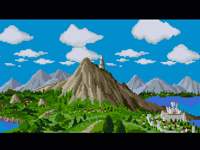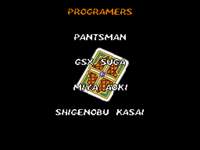Do you remember DirectDraw? The DirectX 5 SDK disc came with a bunch of samples, including one called "Wormhole".
Looks like this:
How it works: despite how the image looks animated, there's no change to the framebuffer data. It's all palette rotation. The sample comes with a bitmap specially chosen so that the colors rotate to produce this 'wormhole' animation.
If you want to try it yourself, load it up from a DirectX 5 SDK disc (it's on some other SDK version discs, as well). Or, you can find it on the Internet Archive here: https://archive.org/details/idx5sdk.
My project: ported this sample to C256 Foenix. (Update: I later also ported it to F256 Foenix.)
This is a language (C to 65816) and platform (Win32+DirectDraw to C256 Foenix + Vicky II) port.
Some of the challenges were:
- Making sure the right bitmap with the right palette gets initialized. See, it's not sufficient to simply read RGB of the original bitmap and emit a new one that looks visually equivalent. The original bitmap's palette needs to be preserved. It contains "dead" colors- colors that aren't referenced by any one pixel as you view it, but are important to the rotation effect. I wrote a tool called BitmapEmbedder to take care of this.
- Betting on how long, in terms of clock, the rotation effect would take to execute. I was bold and put it all in VBLANK handler. Fortunately it fit and I didn't optimize for perf super aggressively. I had no idea whether it would fit. If it didn't, I would've to pull a bunch of it out and synchronize it. And it would be easier to do that at the beginning, before it's all set up. I took the risk at the beginning that it would fit and this paid off.
- Having a loop that needed to be longer than the signed branch distance limit. I could have maybe added a "hop" to get back to the beginning of the loop. Instead I factored out a function for no reason other than to get past the limit. It doesn't make me feel great. Could be something to revisit later.
A bunch of other things worked well. Vicky II has a dedicated bitmap layer that you can cleanly copy to. I say cleanly because it was a lot easier to work with compared to Apple II, and SNES for that matter. There isn't any weird swizzling, interleaving or holes. It was exactly compatible with a DirectDraw surface in terms of indexed color and surface size.
Result looks like: (comparison between the original and the port)
If you aren't familiar with the concept of palette rotation:
Palette rotation is a visual effect made possible by storing image data in a compact way.
You might be familiar with not-very-compact ways to store image data. For each pixel, say, you store a red, green and blue color value. Functionally that works, no worries. But the memory cost- even if each color channel is only two-thirds of a byte, then each pixel will still take up two bytes. Or if each color channel is a byte, you're looking at three bytes then. Or even four if you use alpha. The memory cost can really add up to more than you can afford.
There's a more compact way to store image data. You can store indexed color instead. For each pixel, store a key. The key is only 1 byte, not 4. It's a number from 0 to 255. When the computer displays the image on the screen, it will use that key to look up into a palette, or table of colors. In a way, this limits image quality, since you can only have an image with a low total number of colors (256). But you save a lot of memory. After all, each pixel takes up only one byte.
There are different configurations of key size affecting how many colors you can use at a time. You could sacrifice image quality to optimize for memory even more. Like anything there are tradeoffs. Having a key be one byte is a popular choice though, and this is supported on Vicky II.
Ordinarily, it'd cost a lot of perf to implement palette lookups yourself in your software code. "For each pixel, look up into the palette, assign a color..." It's be so slow. Fortunately, indexed color is an industry-recognized idea that has built-in hardware acceleration on a ton of platforms, including on Vicky II. That's where the benefit really shines, so you don't have to worry.
Anyway, as you see with indexed color, there's indirection. Change one entry in the palette, a simple one-byte change, and it could affect half your image or more. Because of the indirection used with indexed color, an effective way to animate things can be to not animate the image data at all, but to simply make a small change to the palette. The palette has way fewer bytes of data, yet the capacity to change how the whole image looks.
Palette rotation can also be called color cycling. There are some beautiful artworks using color cycling to convey water, snow, or other effects. For example, see this snow effect from this demo page (not my page):
The grid in the lower right shows the palette being changed.
Or this one, with rain:
The Wormhole sample uses the idea of palette rotation to achieve an animation effect. It only copies the original bitmap data once on application start. It never touches it again.
Every VBLANK handler, it only updates the palette. And although it does a lot of manipulations to the palette-- there's four loops, iterating over various parts of it, copying entries around-- it can still be way less expensive than an alternative way of animating things- iterating over every pixel in the bitmap. This way, you can exploit this compactness in the image format to get a performance benefit too.
Source code available here:
https://github.com/clandrew/wormhole/blob/main/vickyii/wormhole.s
Played with this a bit recently. I saved my build for later. To download this build of SerenityOS project, visit here:
Download link (180 MB) - SerenityOS_2_16_2023_43f98ac.zip
To use the provided launcher, QEMU emulator is required. To download QEMU for Windows, visit here:
https://www.qemu.org/download/#windows.
About this operating system: this is an open-source operating system created by a group of hobbyists. Under the hood, it's similar to Unix. At the user interface level, it looks a lot like Windows 95 though.

Build contents:
- _disk_image (1.98 GB, compresses really well)
- Kernel (54.1 MB)
- Launch.bat (2 KB)
- LICENSE (2 KB)
- Prekernel (47 KB)
- README.txt (1 KB)
The Launch.bat script is the same as what as produced from SerenityOS's "launch the operating system in QEMU emulator" script, with one change. I removed
hostfwd=tcp:127.0.0.1:2222-10.0.2.15:22because it conflicts with some Windows TCP exclusion range. You can add it back if you don't use anything that conflicts.
For more information about SerenityOS, visit https://serenityos.org.
For source code, visit https://github.com/SerenityOS/serenity.
For the project's license file, see LICENSE.TXT included with the build, or view it at
https://raw.githubusercontent.com/SerenityOS/serenity/master/LICENSE.
This is an x86-64 build created off of commit hash 43f98ac6e1eb913846980226b2524a4b419c6183 on 2/12/2023.
The build was produced in a WSL environment using Ubuntu 22.04.1 LTS distribution.
Today most people use SerenityOS by running it in an emulator. More specifically they run it in QEMU emulator, emulating a very low spec x64 based computer. There is a subgroup of people investing running it natively on a computer not on an emulator. You can find the discussion group for this on the #bare-metal channel of the SerenityOS Discord server.
To make it so you don't need to water your plants in Harvest Moon for Super Nintendo, use the PAR codes
82A8ACEA
82A8ADEAExplanation below.
The game 'Harvest Moon' for Super Nintendo has fun elements, but also repetitive ones. One of them that wore on me was having to water your plants. If you water at night, it's not even a skill-based action mechanic since you can restore your energy and night lasts forever. I wanted to experience the game and see its content, but not have the repetitive action of watering.
Idea: patch the game so that watering is not needed
First approach was to take memory dumps before and after watering a tile, and diff them. Seems ok. But, the diffs were too noisy and I didn't know what I was looking for. How were the farm tiles stored? Was it even one byte per tile, one byte per pair of tiles, or something else entirely? I didn't even know that part yet, so I gave up on it.
Instead, I tried something way dumber- keep watering a tile with a view of live memory open, and watch for changes. I had an idea of what the storage could be- one byte per tile, arranged sequentially, so I looked for that. And I planted some test plants in an observable pattern. This plus exploiting timing of changes made it way easier to discern signal from noise and I found it.
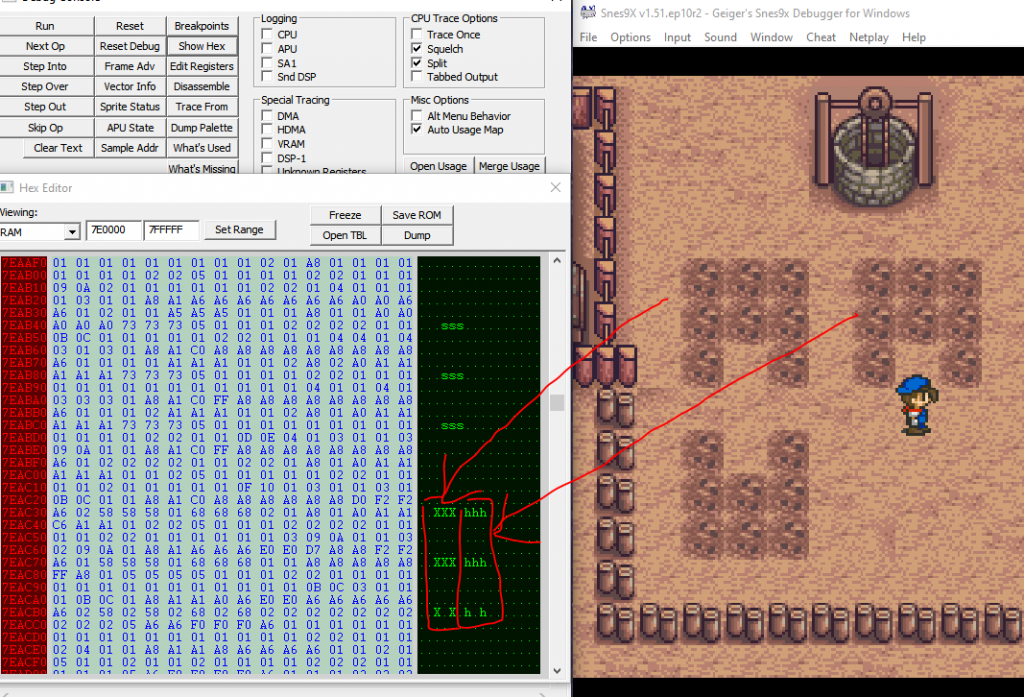
There were not one, but two places the tile data lived. For the tile I'm standing near, the first was at 7E1100 and that one I found first. When I left the farm and came back I saw that the data got wiped and restored, so that meant it's a cache and not the primary copy.
Looking for a dupe of it in memory, I found that at 7EAC30, more likely to be the primary copy.
From experimenting I found this out about the tile storage:
- It is one byte per tile
- Tiles are stored sequentially. Nothing too crazy.
And as for what tile value means what thing, I found
| Tile Value | What It Means |
| 0x00 | Untilled, unwatered ground |
| 0x01 | Untilled, unwatered ground (different graphic from above) |
| 0x07 | Tilled, unwatered ground |
| 0x08 | Tilled, watered ground |
| 0x58 | Unwatered potato seed |
| 0x59 | Watered potato seed |
| 0x68 | Unwatered turnip seed |
| 0x69 | Watered turnip seed |
(Not exhaustive.)
From the data points there are, watering a tile simply increments its value by 1. So when it rains, something must iterate through all the tiles and increment their value by 1.
To find out what that is, I set a break-on-write of 0x7EAC32, the location of the top-left plant, looking for the value to change from 0x58 to 0x59. This took me right into this code
(Paste below is multiple debugging transcripts spliced together so don't put too much stock in the reg values.)
void ProcessWeather()
...
$82/8390 8F 1E 1F 7F STA $7F1F1E[$7F:1F1E] A:0400 X:0400 Y:0400 P:eNvMxdizc
$82/8394 22 D6 89 82 JSL $8289D6[$82:89D6] A:0400 X:0400 Y:0400 P:eNvMxdizc
// Call UpdateFarmTiles, transcribed below
$82/8398 22 11 A8 82 JSL $82A811[$82:A811] A:0400 X:0400 Y:0400 P:eNvMxdizc
$82/839C 22 09 82 82 JSL $828209[$82:8209] A:0400 X:0400 Y:0400 P:eNvMxdizc
...
void UpdateFarmTiles() - $82/A811
// Preconditions:
// Weather is stored at $7E0196. 0x0 means sunny, 0x2 means rainy.
// Farm data is stored around $7EAC30.
// This function is called when you sleep, no matter the weather or if you save.
$82/A811 E2 20 SEP #$20 A:0007 X:000E Y:0002 P:envmxdizC
$82/A813 C2 10 REP #$10 A:0007 X:000E Y:0002 P:envMxdizC
$82/A815 A9 04 LDA #$04 A:0007 X:000E Y:0002 P:envMxdizC
$82/A817 8D 81 01 STA $0181 [$00:0181] A:0004 X:000E Y:0002 P:envMxdizC
$82/A81A C2 20 REP #$20 A:0004 X:000E Y:0002 P:envMxdizC
$82/A81C A0 00 00 LDY #$0000 A:0004 X:000E Y:0002 P:envmxdizC
$82/A81F A2 00 00 LDX #$0000 A:01E0 X:0400 Y:01E0 P:eNvmxdizc
StartProcessingTile:
$82/A822 5A PHY A:00D0 X:00D0 Y:01D0 P:eNvmxdizc
$82/A823 DA PHX A:00D0 X:00D0 Y:01D0 P:eNvmxdizc
$82/A824 86 82 STX $82 [$00:0082] A:00D0 X:00D0 Y:01D0 P:eNvmxdizc
$82/A826 84 84 STY $84 [$00:0084] A:00D0 X:00D0 Y:01D0 P:eNvmxdizc
$82/A828 20 3C B1 JSR $B13C [$82:B13C] A:00D0 X:00D0 Y:01D0 P:eNvmxdizc
$82/A82B E2 20 SEP #$20 A:074D X:074D Y:01D0 P:envmxdizc
// Load the state for a tile in your farm. We look at just 1 byte
$82/A82D BF E6 A4 7E LDA $7EA4E6,x[$7E:AC33] A:074D X:074D Y:01D0 P:envMxdizc
; Do various things for the different tile types.
$82/A831 D0 03 BNE $03 [$A836] A:0758 X:074D Y:01D0 P:envMxdizc
$82/A836 C9 03 CMP #$03 A:0758 X:074D Y:01D0 P:envMxdizc
$82/A838 B0 03 BCS $03 [$A83D] A:0758 X:074D Y:01D0 P:envMxdizC
$82/A83A 4C 1B A9 JMP $A91B [$82:A91B] A:0701 X:074F Y:01D0 P:eNvMxdizc
$82/A83D C9 A0 CMP #$A0 A:0758 X:074D Y:01D0 P:envMxdizC
$82/A83F 90 03 BCC $03 [$A844] A:0758 X:074D Y:01D0 P:eNvMxdizc
$82/A844 C9 06 CMP #$06 A:0758 X:074D Y:01D0 P:eNvMxdizc
$82/A846 D0 03 BNE $03 [$A84B] A:0758 X:074D Y:01D0 P:envMxdizC
$82/A84B C9 07 CMP #$07 A:0758 X:074D Y:01D0 P:envMxdizC ; Is tilled soil?
$82/A84D F0 55 BEQ $55 [$A8A4] A:0758 X:074D Y:01D0 P:envMxdizC
$82/A84F C9 08 CMP #$08 A:0758 X:074D Y:01D0 P:envMxdizC
$82/A851 D0 03 BNE $03 [$A856] A:0758 X:074D Y:01D0 P:envMxdizC
$82/A856 C9 1E CMP #$1E A:0758 X:074D Y:01D0 P:envMxdizC
$82/A858 F0 4A BEQ $4A [$A8A4] A:0758 X:074D Y:01D0 P:envMxdizC
$82/A85A C9 1F CMP #$1F A:0758 X:074D Y:01D0 P:envMxdizC
$82/A85C D0 03 BNE $03 [$A861] A:0758 X:074D Y:01D0 P:envMxdizC
$82/A861 C9 1D CMP #$1D A:0758 X:074D Y:01D0 P:envMxdizC
$82/A863 D0 03 BNE $03 [$A868] A:0758 X:074D Y:01D0 P:envMxdizC
$82/A868 C9 20 CMP #$20 A:0758 X:074D Y:01D0 P:envMxdizC
$82/A86A B0 03 BCS $03 [$A86F] A:0758 X:074D Y:01D0 P:envMxdizC
$82/A86F C9 39 CMP #$39 A:0758 X:074D Y:01D0 P:envMxdizC
$82/A871 D0 03 BNE $03 [$A876] A:0758 X:074D Y:01D0 P:envMxdizC
$82/A876 C9 53 CMP #$53 A:0758 X:074D Y:01D0 P:envMxdizC
$82/A878 D0 03 BNE $03 [$A87D] A:0758 X:074D Y:01D0 P:envMxdizC
$82/A87D C9 61 CMP #$61 A:0758 X:074D Y:01D0 P:envMxdizC
$82/A87F D0 03 BNE $03 [$A884] A:0758 X:074D Y:01D0 P:eNvMxdizc
$82/A884 C9 6F CMP #$6F A:0758 X:074D Y:01D0 P:eNvMxdizc
$82/A886 D0 03 BNE $03 [$A88B] A:0758 X:074D Y:01D0 P:eNvMxdizc
$82/A88B C9 79 CMP #$79 A:0758 X:074D Y:01D0 P:eNvMxdizc
$82/A88D D0 03 BNE $03 [$A892] A:0758 X:074D Y:01D0 P:eNvMxdizc
$82/A892 C9 7C CMP #$7C A:0758 X:074D Y:01D0 P:eNvMxdizc
$82/A894 D0 03 BNE $03 [$A899] A:0758 X:074D Y:01D0 P:eNvMxdizc
$82/A899 C9 70 CMP #$70 A:0758 X:074D Y:01D0 P:eNvMxdizc
$82/A89B B0 69 BCS $69 [$A906] A:0758 X:074D Y:01D0 P:eNvMxdizc
$82/A89D 29 01 AND #$01 A:0758 X:074D Y:01D0 P:eNvMxdizc ; Mask
$82/A89F F0 03 BEQ $03 [$A8A4] A:0700 X:074D Y:01D0 P:envMxdiZc
...
$82/A8A4 C2 20 REP #$20 A:0700 X:074D Y:01D0 P:envMxdiZc
$82/A8A6 AD 96 01 LDA $0196 [$00:0196] A:0700 X:074D Y:01D0 P:envmxdiZc ; Load weather
; 0x0 means sunny.
; 0x2 means rainy.
$82/A8A9 29 02 00 AND #$0002 A:0002 X:074D Y:01D0 P:envmxdizc
; If not rainy, skip ahead--
$82/A8AC F0 03 BEQ $03 [$A8B1] A:0002 X:074D Y:01D0 P:envmxdizc
; If it is rainy, goto IncrementTileValue to mark the tile as watered.
$82/A8AE 4C 06 A9 JMP $A906 [$82:A906] A:0002 X:074D Y:01D0 P:envmxdizc
...
IncrementTileValue:
; This is a common path for all kinds of tile incrementing, it's not just for rain.
$82/A906 E2 20 SEP #$20 A:0002 X:074D Y:01D0 P:envmxdizc
; Load early-out cond
$82/A908 AF 19 1F 7F LDA $7F1F19[$7F:1F19] A:0002 X:074D Y:01D0 P:envMxdizc
$82/A90C C9 03 CMP #$03 A:0000 X:074D Y:01D0 P:envMxdiZc ;
$82/A90E F0 59 BEQ $59 [$A969] A:0000 X:074D Y:01D0 P:eNvMxdizc ;
; Load tile value
$82/A910 BF E6 A4 7E LDA $7EA4E6,x[$7E:AC33] A:0000 X:074D Y:01D0 P:eNvMxdizc
; Apply 'watered' status
$82/A914 1A INC A A:0058 X:074D Y:01D0 P:envMxdizc
WriteRainEffect:
; X=0x74C means just to the right of shipping bin.
; Value of 0x59 means 'watered'.
$82/A915 9F E6 A4 7E STA $7EA4E6,x[$7E:AC32] A:0059 X:074C Y:01D0 P:envMxdizc
; Goto DoneProcessingTile.
$82/A919 80 4E BRA $4E [$A969] A:0059 X:074C Y:01D0 P:envMxdizc
...
OnUntilledSoil:
$82/A91B E2 20 SEP #$20 A:0701 X:074F Y:01D0 P:eNvMxdizc
$82/A91D AF 19 1F 7F LDA $7F1F19[$7F:1F19] A:0701 X:074F Y:01D0 P:eNvMxdizc
$82/A921 C9 02 CMP #$02 A:0700 X:074F Y:01D0 P:envMxdiZc
$82/A923 F0 44 BEQ $44 [$A969] A:0700 X:074F Y:01D0 P:eNvMxdizc
$82/A925 C9 03 CMP #$03 A:0700 X:074F Y:01D0 P:eNvMxdizc
$82/A927 F0 40 BEQ $40 [$A969] A:0700 X:074F Y:01D0 P:eNvMxdizc
$82/A929 AF 1B 1F 7F LDA $7F1F1B[$7F:1F1B] A:0700 X:074F Y:01D0 P:eNvMxdizc
$82/A92D 29 03 AND #$03 A:0706 X:074F Y:01D0 P:envMxdizc
$82/A92F D0 38 BNE $38 [$A969] A:0702 X:074F Y:01D0 P:envMxdizc ; Goto DoneProcessingTile
...
DoneProcessingTile:
$82/A969 C2 30 REP #$30 A:0059 X:074C Y:01D0 P:envMxdizc
$82/A96B FA PLX A:0059 X:074C Y:01D0 P:envmxdizc
$82/A96C 7A PLY A:0059 X:00C0 Y:01D0 P:envmxdizc
$82/A96D 8A TXA A:0059 X:00C0 Y:01D0 P:envmxdizc
$82/A96E 18 CLC A:00C0 X:00C0 Y:01D0 P:envmxdizc
$82/A96F 69 10 00 ADC #$0010 A:00C0 X:00C0 Y:01D0 P:envmxdizc
$82/A972 AA TAX A:00D0 X:00C0 Y:01D0 P:envmxdizc
$82/A973 E0 00 04 CPX #$0400 A:00D0 X:00D0 Y:01D0 P:envmxdizc
$82/A976 F0 03 BEQ $03 [$A97B] A:00D0 X:00D0 Y:01D0 P:eNvmxdizc
$82/A978 4C 22 A8 JMP $A822 [$82:A822] A:00D0 X:00D0 Y:01D0 P:eNvmxdizc
DoneProcessingField:
$82/A97B 98 TYA A:0400 X:0400 Y:01D0 P:envmxdiZC
$82/A97C 18 CLC A:01D0 X:0400 Y:01D0 P:envmxdizC
$82/A97D 69 10 00 ADC #$0010 A:01D0 X:0400 Y:01D0 P:envmxdizc
$82/A980 A8 TAY A:01E0 X:0400 Y:01D0 P:envmxdizc
$82/A981 C0 00 04 CPY #$0400 A:01E0 X:0400 Y:01E0 P:envmxdizc
$82/A984 F0 03 BEQ $03 [$A989] A:01E0 X:0400 Y:01E0 P:eNvmxdizc
$82/A986 4C 1F A8 JMP $A81F [$82:A81F] A:01E0 X:0400 Y:01E0 P:eNvmxdizc
...This provides enough information to understand how the 'watered' status gets applied. So to apply watered status irrespective of rain, you can just change the branch below
$82/A8A9 29 02 00 AND #$0002 A:0002 X:074D Y:01D0 P:envmxdizc
; If not rainy, skip ahead--
$82/A8AC F0 03 BEQ $03 [$A8B1] A:0002 X:074D Y:01D0 P:envmxdizc
; If it is rainy, goto IncrementTileValue to mark the tile as watered.
$82/A8AE 4C 06 A9 JMP $A906 [$82:A906] A:0002 X:074D Y:01D0 P:envmxdizcto no ops. In other words, change
82A8AC: F0
82A8AD: 03to
82A8AC: EA
82A8AD: EAExpressing this as a PAR code, it looks like
82A8ACEA
82A8ADEASee a demo of the change
It's a bit more fun this way. Enjoy
On WDC 65816, NMI isn't a "real" instruction.
It's a directive ("non-maskable interrupt") typical 65816 assemblers understand.
You use the directive like
NMI MyHandlerwhere MyHandler is a label in the source code.
I had trouble finding this information written anywhere plainly, so I'm writing this in case you or someone else is in the same position as me where you need to know.
In response to NMI, the assembler doesn't directly emit any opcodes. What it will do for SNES, anyway, is
- After assembly, look at the object code address of MyHandler.
- The short, 16-bit address. Why? Because interrupts have to be in bank 0.
- Write the address to 0x7FEA or 0xFFEA, depending on whether it's LoROM or HiROM.
- The rule is that the vectors live in the last page of the first ROM bank, so that's in 0x7FEA for LoROM or 0xFFEA for HiROM.
Fun fact: in Geiger, you can't set a breakpoint to code inside an NMI. Well, you can try, but it won't hit. If you want to see control flow through an NMI, you can use the Logging-CPU feature.
After you assemble and load your program, and execute to something that entails an interrupt, your interrupt handler will get called automagically.
The choice of "what raises NMI" is up to the computer manufacturer. On SNES, the NMI vector is called when VBlank begins. That's just how it is. So sometimes NMI and VBlank get talked about interchangeably on that platform.
And I wish I had known to don't get hardware and software interrupts confused. NMI is different from BRK and COP. Those are software interrupts. They have an instruction, they launch from an opcode. NMI is a hardware interrupt.
For hardware interrupts, the K (program bank reg) gets automatically pushed, then the 16-bit PC is pushed, then the P (processor flags reg) is pushed, then there's this automatic transfer of control to the interrupt handler. You drop everything you're doing and go right to the handler. At least the CPU has the decency to push the execution state beforehand, I guess.
One detail- in emulation mode, the program bank reg does not get pushed. So you probably want to NOT be executing code in a nonzero bank in emulation mode if there's a hardware interrupt, because you don't know where to return to when the interrupt handler is done.
For NMI, the whole thing is no you can't disable it with a processor flag (that is, 'i') so forget trying to disable them either. And since it's a hardware interrupt, it's set up by special vector not by an instruction like BRK or COP. For those software interrupts, you can predict when they'll happen or make it so they're never happen since you know where there's a BRK or COP in your code. Hardware interrupts are different- you can't decide when they occur like that. The condition that raises them is fixed. Fortunately I guess, they're fixed based on something useful like vertical blank. And fair enough, since there are lots of things that are only safe to do during vertical blank.
I haven't had to write code that chases scanlines. I hope you don't either, although it might happen to everyone at some point.
A lot of the SNES reference material I used emphasize 65816 which is great for a while. But you get to a point in debugging SNES where it's not enough to only know things about the CPU. Eventually you will see things in the debugger you can't explain. Since there's more to a computer than just the CPU.
J. R. R. Tolkien's Lord of the Rings for Super Nintendo shipped with a bug as you get toward the later parts of the game.
Short version: use these Pro Action Replay codes to un-glitch the late-game passwords.
81CBF10C
81A3900C
81A35C0CLonger explanation below.
If you're in Moria past the entrance and the first part and request a password, the game will give you one. However, if you write down and try to use that same password later, the game won't accept it.
This is especially troublesome because
a) it's in the most tedious part of the game, a part you wouldn't ever want to re-do, and
b) even if you back-track to the Moria entrance, it won't go back to giving you valid passwords. The game's password system is basically cursed.
I investigated to understand this more. First, the password validation converts this character into a number.

The exact way it does this is described in an earlier post. So for here, L is 9, M would be 10, and so on.
Starting from there, I found out more by
- typing a numerical garbage password like "023741" into the first six characters
- taking memory dump of RAM
- running a relative searcher on the memory dump, looking for a pattern like the one above
- found one result. This was lucky in a bunch of ways. It was lucky how the number was indeed stored contiguously in RAM, not immediately over-written, the password characters' values are sequential (e.g., the value of password character '1' numerically comes right before '2') and that I had picked a unique enough number
- Used that to get the RAM address of the character boxed in red above
- Set a break-on-read of that RAM address in the debugger
- Breakpoint hit when you press the button for password confirm. This also, was a bit lucky. The game only read the password back for initial graphics or when you hit 'confirm'. No reading it back continuously, no noisy breakpoints.
- Stepped through in debugger to see what it did with the password character. When it copied the password character, set break-on-read of that too. This led to un-tangling the password characters from what I called the AreaNumbers below. I saved the code and marked it up with comments and labels.
Password validation calls this function
// Function: ReadPasswordLocationCode()
// Precondition: location code is stored at $81:039C
// Postcondition: result stored in 801CCB, 801CCD, 801CC9.
// The result is what I'm calling an "AreaNumber"
// plus positional information about
// where in the world to load the player.
//
// Early-game AreaNumbers are high-numbered.
// Late-game ones are low.
// Examples:
// Crossroads is 0x12A.
// Rivendell is 0x138.
// Moria Entrance is 0xEF.
// Moria 1 is 0x51.
// Moria 2 is 0x0C.
$81/CBEA B9 84 03 LDA $0384,y[$81:039C] ; Load location code. E.g., the password
; character 'M', which is 0xA
$81/CBED 29 1F 00 AND #$001F ; Ignore upper bits
$81/CBF0 C9 0A 00 CMP #$000A
$81/CBF3 90 02 BCC $02 [$CBF7] ; If the password character is equal or greater than
;'M' (0xA), fall through
; to LocationCodeTooHigh.
; Otherwise, goto LocationCodeOk.
LocationCodeTooHigh:
$81/CBF5 38 SEC
$81/CBF6 6B RTL ; Bail
LocationCodeOk:
$81/CBF7 85 90 STA $90 [$00:0090]
$81/CBF9 A5 90 LDA $90 [$00:0090]
$81/CBFB 0A ASL A
$81/CBFC AA TAX
// Write the output
$81/CBFD BF 18 CC 81 LDA $81CC18,x[$81:CC2A]
$81/CC01 8F CB 1C 80 STA $801CCB[$80:1CCB]
$81/CC05 BF 30 CC 81 LDA $81CC30,x[$81:CC42]
$81/CC09 8F CD 1C 80 STA $801CCD[$80:1CCD]
$81/CC0D BF 48 CC 81 LDA $81CC48,x[$81:CC5A]
$81/CC11 8F C9 1C 80 STA $801CC9[$80:1CC9]
$81/CC15 C8 INY
$81/CC16 18 CLC
$81/CC17 6B RTL It's pretty easy to see the problem. It validates your location code is too high if you specify 'M' or 'N', but those are codes the game gives you. It was clearly a mistake. Changing the line
$81/CBF0 C9 0A 00 CMP #$000Ato
$81/CBF0 C9 0C 00 CMP #$000Cwill fix it, allowing through AreaNumbers up to N (since a password character N = 11 = 0xB), the maximum the game will give you.
This unblocks the password validation code. But, if you were to patch the above change and try it, you'd see the screen fade but hang there forever spinning in a long loop and hard locked not loading the level. So we're not out of the woods yet.
Terminology
Crashed, halted- the game's computer stopped executing instructions
Hard lock- the game's computer is executing instructions, but it appears unresponsive to inputs e.g., the screen is black
Soft lock- the game displays graphics and appears responsive but can not be won
The hang happens because we get past the password-validation and into level-loading yet there's parts of the level loading code that block out AreaNumbers belonging to Moria.
We get here
// Function: AreaLoadStaging()
// Preconditions: Location codes have been written to 801CCB, 801CCD 801CC9
// Expected behavior: Sanitize out bad location codes (e.g., bad
// AreaNumbers) and call a common function AreaLoadHelper().
// AreaLoadHelper() is a common channel used during both password-based
// loading and normal level loading as you move from one place to another
// in the game.
$81/A377 E2 30 SEP #$30
$81/A379 AF 0E 1D 80 LDA $801D0E
$81/A37D CF 72 03 80 CMP $800372
$81/A381 F0 76 BEQ $76
$81/A383 AF 72 03 80 LDA $800372
$81/A387 30 70 BMI $70
$81/A389 C2 20 REP #$20
$81/A38B AF C5 1C 80 LDA $801CC5 ; Load the area number.
$81/A38F C9 54 00 CMP #$0054
$81/A392 B0 52 BCS $52 [$A3E6] ; If area number < 54, fall through to
; InvalidAreaNumber_TooLow.
; Otherwise, goto ValidAreaNumber.
InvalidAreaNumber_TooLow:
$81/A394 E2 20 SEP #$20
$81/A396 AF 0E 1D 80 LDA $801D0E
$81/A39A C9 04 CMP #$04
$81/A39C D0 0E BNE $0E
$81/A3AC E2 20 SEP #$20
$81/A3AE A9 00 LDA #$00
$81/A3B0 48 PHA
$81/A3B1 AF 72 03 80 LDA $800372
$81/A3B5 48 PHA
$81/A3B6 F4 06 00 PEA $0006
$81/A3B9 22 02 80 81 JSL $818002
$81/A3BD 85 34 STA $34 ; Fall through into BadLoop
BadLoop:
$81/A3BF A9 00 LDA #$00
$81/A3C1 48 PHA
$81/A3C2 AF 72 03 80 LDA $800372
$81/A3C6 48 PHA
$81/A3C7 F4 06 00 PEA $0006
$81/A3CA 22 02 80 81 JSL $818002
$81/A3CE C5 34 CMP $34
$81/A3D0 F0 ED BEQ $ED
// This hangs forever :(
ValidAreaIndex:
$81/A3E6 E2 20 SEP #$20
$81/A3E8 A9 00 LDA #$00
//... clipped for brevityThis code snippet makes reference to another function I'm calling AreaLoadHelper. I'm not posting the code to AreaLoadHelper because it's veering a bit off topic. If you want to see the code for that, it's here. Look for 'Function: AreaLoadHelper() - 801D0D'.
Looking through, it's possible they originally intended for bad location codes to do something more elegant than a hang in this function (early out?). Or perhaps not, if they were sure this code wasn't reachable.
Anyway, changing
$81/A38F C9 54 00 CMP #$0054to
$81/A38F C9 0C 00 CMP #$000C fixes it here. The AreaNumbers for the last two levels are 0051 and 000C, so 0C covers it. The fact that it's the same number as patched above is really a coincidence.
If you were to apply this change and run the game, you would still see the same symptom as before where the screen would fade to black yet no level would get loaded. This is because it gets further in the level-loading code before getting stuck again. It was a very loose spin. I had an unpleasant debugging experience. That's because if you break in the debugger while it's hanging, you're too late. The root cause of the hang was here
// Function: CallAreaLoadHelperArg4 ($81:A33A)
// Preconditions: An AreaNumber is passed in through address $80:1CC5.
// Expected result: Validate the AreaNumber.
// If valid, push the argument '4' onto the stack and then call AreaLoadHelper(),
// a common code path shared between password-loading usual traversal
// through the game world.
$81/A33A E2 30 SEP #$30
$81/A33C AF 0E 1D 80 LDA $801D0E
$81/A340 CF 72 03 80 CMP $800372
$81/A344 F0 2E BEQ $2E
$81/A346 AF 72 03 80 LDA $800372
$81/A34A 30 28 BMI $28
$81/A34C C2 20 REP #$20
$81/A34E AF C3 1C 80 LDA $801CC3
$81/A352 C9 EF 00 CMP #$00EF
$81/A355 F0 09 BEQ $09
$81/A357 AF C5 1C 80 LDA $801CC5
$81/A35B C9 54 00 CMP #$0054 ; Load AreaNumber
$81/A35E 90 14 BCC $14 [$A374] ; If too low, goto InvalidLocation.
; If okay, fall through to ValidAreaNumber
ValidAreaNumber:
$81/A360 E2 20 SEP #$20
$81/A362 A9 00 LDA #$00
$81/A364 48 PHA
$81/A365 AF 72 03 80 LDA $800372
$81/A369 48 PHA
$81/A36A F4 00 01 PEA $0100
$81/A36D F4 04 00 PEA $0004 ; Push args
$81/A370 22 02 80 81 JSL $818002[$81:8002] ; Call AreaLoadHelper()
InvalidLocation:
$81/A374 C2 30 REP #$30
$81/A376 6B RTL Another place where the validation is on the wrong bounds.
So, change
$81/A35B C9 54 00 CMP #$0054 to
$81/A35B C9 0C 00 CMP #$000Callowing through both within-Moria area numbers, it works.
It is kind of good password-resuming the last two areas was something superficial like this, and not a deeper problem like a huge swath of level loading being actually not implemented. It turns out, the odds a "not implemented" is low anyway, since that part was written in a reasonable way- i.e., if you can visit an area, you can password-resume to it. They share the same code.
As for the fix since the total amount of changes is small, you could use a ROM patch, but it's even easier as a cheat code like a Pro Action Replay code. Expressing the above changes as SNES Pro Action Replay the codes are
81CBF10C
81A3900C
81A35C0CThese are value changes to ROM code (it is not self modified), so if you're applying cheats in an emulator you don't need to re-start the game to apply them.
Here is a demo of the codes in action
I was gonna post this to GameFaqs but they have this

oh well.
Anyway, you can use the cheat codes in a Pro Action Replay device for Super Nintendo, or any mainstream emulator (tested ZSNES, Snes9x) to unblock the game. Enjoy
This is an explanation of the formats of the password used in the game. I found this information by trying different passwords and seeing what is accepted by the game and what the effects were. Since this process didn't involve a debugger it could have been done on the console, but using an emulator sped this up a lot.

This game has a hugely long password (48 characters.)

Each alphanumeric character is one of
.BCDFGHJKLMNPQRSTVWXYZ0123456789That's a '.', the letters of the alphabet with no vowels plus the numbers 0 through 9. This gives 32 choices in total.
The general layout of the password is: (where '.' represents an alphanumeric character)
Samwise Merry Frodo Pippin
[ ][ ] [ ][ ]
. . . . . . . . . . . .
Legolas Aragorn Gimli Gandalf
[ ][ ] [ ][ ]
. . . . . . . . . . . .
Spawn location keys Checksum
[ ][ and events ][ ]
. . . . . . . . . . . .
Inventory
[ ]
. . . . . . . . . . . .
As shown above there's
- 3 characters for each of the 8 people in the fellowship (Boromir isn't joinable)
- 1 character for your spawn location
- 8 characters representing keys and events
- 3 characters for checksum
- and a 12-character inventory code at the bottom labeled 'INVENTORY CODE' in the password input screen.
Following goes into more detail for each of these.
Password characters
The alphanumeric password is a convenience (lol) for the user. Internally the game maps each character in a password to a number.
The mapping is this
Character | Value
------------------
. | 0
B | 1
C | 2
D | 3
F | 4
G | 5
H | 6
J | 7
K | 8
L | 9
M | 10
N | 11
P | 12
Q | 13
R | 14
S | 15
T | 16
V | 17
W | 18
X | 19
Y | 20
Z | 21
0 | 22
1 | 23
2 | 24
3 | 25
4 | 26
5 | 27
6 | 28
7 | 29
8 | 30
9 | 31 In the sections that follow, these numerical representations of password characters get used and there is math done on them.
People in the fellowship
For each joinable person in the fellowship there's a three-character code that encodes their level and equipment.
Firstly, if the three character code is all '.' (value zeroes), that character is not in your party. Otherwise yes they are in your party.
The way in which the codes determine equipment is a bit convoluted and broken. The reason I say that is there are some
passwords that are accepted by the game but will either crash the game or cause corrruption while you're playing. The charts and things below describe passwords which are accepted and also don't crash or corrupt the game.
You can find situations (e.g., what if Code3, described below, is less than 16?) where the password gets accepted, the level gets loaded and things appear okay but corruption happens when you go into the menu for example. I reverse engineered what level/items you get in those cases too, and they're accounted for in the source code of my password editor. I'm leaving them out of this document so that these formulas stay neat and concise as they're specified, because those don't follow the rules listed below. If you want you can see source code here for more info on them
So anyway, each person in the fellowship gets a three-character code in the password. Call the three characters in the code
Code1, Code2, and Code3 in order.
For example if the password contained 'B89' then Code1=1, Code2=30, Code3=31 referring to the chart above. Yes, each of
Code1, Code2 and Code3 is a number between 0 and 31 inclusive.
Level is decided by the following:
if (Code1 < 10)
Level = (Code2 mod 8) * 20 + Code1
else
Level = (Code2 mod 8) * 20 + (Code1 mod 16) + 10The 'mod' operator here is modulus. I.e., A mod B is the remainder when A is divided by B.
Armor is decided by the following:
PW char 2 | Code2 | Armor
--------------------------------------------------------------
. through F | 0 through 4 | If Code3 is even, Cloth Cloak.
| | If Code3 is odd, Plate Mail.
--------------------------------------------------------------
. through F | 0 through 4 | If Code3 is even, Cloth Cloak.
| | If Code3 is odd, Plate Mail.
--------------------------------------------------------------
K through P | 8 through 12 | If Code3 is even, Padded Armor.
| | If Code3 is odd, Mithril Armor
--------------------------------------------------------------
T through Y | 16 through 20 | Leather Armor
--------------------------------------------------------------
2 through 6 | 24 through 28 Chain Mail
Weapons are decided by the following:
PW char 3| Code3 | Weapon
----------------------------
T | 16 | Old Dagger
V | 17 | Old Dagger
W | 18 | Dagger
X | 19 | Dagger
Y | 20 | Barrow Dagger
Z | 21 | Barrow Dagger
0 | 22 | Troll Dagger
1 | 23 | Troll Dagger
2 | 24 | Elvish Dagger
3 | 25 | Elvish Dagger
4 | 26 | Sting
5 | 27 | Sting
6 | 28 | Light Sword
7 | 29 | Light Sword
8 | 30 | Sword
9 | 31 | Sword The password encoding for level, weapon and armor works the same for each of the 8 joinable characters.
Fun fact: if you enter an only-partially-valid password that includes some configuration for a character (e.g., the string is not all '.'), it permanently adds the character to your party until SNES reset. Even if the password is rejected. This leads to a well-known cheesy trick where you can enter a bad password, press start and hear the "invalid password" noise, then delete it and start the game with all the Fellowship unlocked.
Spawn Location
This is the place in the game world your party will be in after the password gets accepted.
It's a 1-character code.
PW char| Code | Location
-------|------|------------
. | 0 | Hobbiton
B | 1 | Brandywine Bridge
C | 2 | Farmer Maggot
D | 3 | Ferry
F | 4 | Crickhollow
G | 5 | Tom Bombadil's House
H | 6 | Barrow Downs Stones
J | 7 | Crossroads
K | 8 | Rivendell
L | 9 | Moria entrance
M | 10 | Moria 1 (glitched)
N | 11 | Moria 2 (glitched) For the last two Moria locations, the game will include those location codes in the passwords it provides to you when you're in Moria.
However, it won't accept the passwords the next time you start the game 🙁 (Update: unless you have my bug fix described in this post)
Might want to keep a map of Moria, you definitely don't want to do it more than once if you can help it
Keys and events
These control the state of various unlockable doors and questlines. I haven't investigated which bits control what because it wasn't important to what I was trying to do.
Checksum
The checksum exists to stop you from trying random passwords and cheating. It's a way of making sure the only passwords accepted are ones the game has actually given to you, not ones you randomly made up yourself.
However, the checksum is pretty easy to understand if you look at the various passwords it gives you. For example, you'll see that leveling up or changing equipment only changes the first character. And using something in your inventory only changes the third character. And, you know how the password characters translate to character codes and there are 32 of them, and modulus kinds of operations are common and inexpensive for computing checksums.
The first character is the 'party checksum':
partySum = the sum of the character codes of the first two lines of the password
checksumCode = remainder when partySum is divided by 32. (For example, if partySum is 33, the checksumCode is 1.)
The second character is the 'event checksum':
eventSum = the sum of the character codes in the "spawn location" and "keys and events" part of the password
checksumCode = remainder when eventSum is divided by 32
The third character is the 'inventory checksum':
inventorySum = the sum of the character codes in the "inventory" part of the password
checksumCode = remainder when inventorySum is divided by 32
This gives you the first, second and third characters of the checksum in order.
I think they put the checksum in the middle of the password to obfuscate it a little bit.
If you're trying to troubleshoot, know that valid checksum doesn't necessarily mean the password will be accepted. The game sometimes rejects passwords for reasons other than invalid checksum. For example, if you specify an invalid location code like 'Z'.
Inventory
These character codes store your inventory state pretty compactly.
Each item corresponds to 1 bit within a byte. Not all the bits are used, which is why a full inventory's password code looks like "9S9S9S 9S9S9S" rather than all 9s (all 9s means all bits set).
There are 12 inventory code characters in all, which I'm calling code 0 through 11.
For readability the bit is written as a hexadecimal flag.
Item |Code #| Bit
--------------------------------
Tomb Key | 0 | 0x1
Moria Key | 0 | 0x2
Red Gateway Gem | 0 | 0x4
Elvish Book | 0 | 0x8
Magic Rock | 0 | 0x10
Bottle | 1 | 0x1
Lost Amulet | 1 | 0x2
Maggot Note | 1 | 0x4
Scroll Of Floi | 1 | 0x8
Gate Key | 2 | 0x1
Moria Key | 2 | 0x2
Yellow Gateway Gem | 2 | 0x4
Book Of The Ages | 2 | 0x8
Gold Piece | 2 | 0x10
Jug Of Honey | 3 | 0x1
Lost Amulet | 3 | 0x2
Old Willow Note | 3 | 0x4
Scroll Of Oin | 3 | 0x8
Tomb Key | 4 | 0x1
Moria Key | 4 | 0x2
Gateway Keystone | 4 | 0x4
Book Of Mazarbul | 4 | 0x8
Gold Pieces | 4 | 0x10
Eye Glasses | 5 | 0x1
Lost Amulet | 5 | 0x2
Note From Gandalf | 5 | 0x4
Color Scoll | 5 | 0x8 Item |Code #| Bit
---------------------------------
Tomb Key | 6 | 0x1
Moria Key | 6 | 0x2
Green Gateway Gem | 6 | 0x4
Bilbo Diary | 6 | 0x8
Gold Pieces | 6 | 0x10
Healing Moss | 7 | 0x1
Lost Amulet | 7 | 0x2
Letter To Elrond | 7 | 0x4
Keystone Scroll | 7 | 0x8
Tomb Key | 8 | 0x1
Boat Oar | 8 | 0x2
Purple Gateway Gem | 8 | 0x4
Jeweled Ring | 8 | 0x8
Gold Pieces | 8 | 0x10
Athelas Major | 9 | 0x1
Lost Amulet | 9 | 0x2
Horn Of Boromir | 9 | 0x4
Long Bow | 9 | 0x8
Key To Bree | 10 | 0x1
Healing Mushroom | 10 | 0x2
Violet Gateway Gem | 10 | 0x4
The Ring | 10 | 0x8
Athelas Minor | 10 | 0x10
Healing Fruit | 11 | 0x1
Lost Amulet | 11 | 0x2
Magic Fern | 11 | 0x4
Orb of Drexle | 11 | 0x8 The inventory codes come from bitwise OR-ing the corresponding bits together for each inventory item you have.
For example, suppose you have the first tomb key and the red gateway gem. This is bit '0x1' and '0x4'. When you bitwise-OR these, you get '5'. Code 5 corresponds to password code 'G', from the chart all the way at the top. So if those two are the only items you have, your inventory code in the password is 'G….. ……'.
For another example, suppose all you have is the first tomb key and the Orb of Drexle. This is bit '0x1' of the first code, and '0x8' of the last. So if those were the only two items you have, your inventory code in the password is 'B….. …..K'.
There's one special case- although there's an inventory bit allocated to the One Ring, the ring is always in your inventory regardless of whether it's encoded in the password or not.
Links
Hope you found this helpful
All this information is used in a password editor I made. That is here
https://github.com/clandrew/lotrpwcheck/
To view this post in text form, it's here
https://raw.githubusercontent.com/clandrew/lotrpwcheck/master/Format.txt
This post is following up from this one where I posted the editor, where someone asked about the information that the editor uses
This post describes how to change players' names arbitrarily (longer or shorter) in the game NHL '94 for Super Nintendo by changing the ROM.
Players' names are shown as text in the menus and in-game.
In the team selection menu, it's their first initial and last name. In other places, it's the full first and last name.
Goal is to change how names appear in all these places. Have new names' length be allowed to be different from the old names.
My own intended usage for this is to only change a few names, so optimize for that. And optimize for game stability because I plan to play the game, not just do a quick demo. I don't care if the result is not elegant or wasteful in terms of memory. The result can operate on an expanded ROM.
The Very Easy, Very Limited Way
Easiest way to change names is a pure data hack. Doesn't require any knowledge about SNES at all, only basic computer literacy. Open the ROM in a hex editor such as HxD. Scroll down until you see players' names on the right, and type over them. Hit Ctrl+S to save. Start your game and go.
Why does this work? Because all player names are literally stored as ASCII, no need for character translation tables or whatever. Also, each name is only stored in 1 place for the most part.
But of course, the catch is whatever new name you pick has to be the same length or shorter. Ideally, the same length. Shorter only kind of works because you can pad names with spaces, but no guarantees that'll look right when you see it laid out on the screen. And if the new name is longer it definitely won't work. Since the goal is to let you change names without length restrictions we have to do something more.
The reasons why you can't change the name length as a pure data hack take some context to explain. So they are explained further down. The first thing you need to know is the data you just tried to hack- what is it, really.
Player-data Format
This describes where and how players' names are stored in the ROM, as well as the neighboring data.
There is what I'm calling a "main pointer table". The table has 28 values. This table is stored at ROM address 0x9CA5E7.
If you dump the raw data for the table it's
4F EB 9C 00 AC AB 9C 00 32 AE 9C 00 C1 B0 9C 00
40 B3 9C 00 4F C0 9C 00 D7 B5 9C 00 9D B8 9C 00
4D E9 9C 00 1D BB 9C 00 B2 BD 9C 00 DB C2 9C 00
7E C5 9C 00 2B C8 9C 00 9C CA 9C 00 06 CD 9C 00
AC CF 9C 00 37 D2 9C 00 D2 D4 9C 00 60 D7 9C 00
D4 D9 9C 00 4A DC 9C 00 DC DE 9C 00 7E E1 9C 00
AD E6 9C 00 05 E4 9C 00 57 A6 9C 00 04 A9 9C 00Formatted nicely, the table is
int mainTable[] = {
9CEB4F, // Anaheim
9CABAC, // Boston
9CAE32, // Buffalo
9CB0C1, // Calgary
9CB340, // Chicago
9CC04F, // Dallas
9CB5D7, // Detroit
9CB89D, // Edmonton
9CE94D, // Florida
9CBB1D, // Hartford
9CBDB2, // LA Kings
9CC2DB, // Montreal
9CC57E, // New Jersey
9CC82B, // NY Islanders
9CCA9C, // NY Rangers
9CCD06, // Ottawa
9CCFAC, // Philly
9CD237, // Pittsburgh
9CD4D2, // Quebec
9CD760, // San Jose
9CD9D4, // St Louis
9CDC4A, // Tampa Bay
9CDEDC, // Toronto
9CE17E, // Vancouver
9CE6AD, // Washington
9CE405, // Winnepeg
9CA657, // All Stars East
9CA904 // All Stars West
};There is 1 value per hockey team.
The first element in the array belongs to Anaheim, and the value is 0x9CEB4F.
The second element in the array belongs to Boston, and the value is 0x9CABAC, and so on.
The teams are ordered alphabetically, except for the all-stars teams at the end. The values themselves aren't in any particular order.
Although the all-stars teams are comprised of players which exist on other teams, they have their own entries in the table. That's the game opting for perf and simplicity of code in the perf-memory tradeoff.
Looking at the values of elements in this array, you might think they also look like ROM addresses and you would be right.
As for what's stored at each address- here's a description
[H0] [H1] [some number of header bytes] // A two-byte low-endian length H, and a variable-length
// header stream of length H-2
For each player:
[L0] [L1] [player's name] // A two-byte low-endian length L, and then a variable-length string
// of length L-2
[PlayerNumber] // A byte for the player number. It's in a decimal format.
// Leftmost half-byte is the tens place value. Rightmost half-byte is
// the ones place value.
[WeightClass, Agility] // A byte. Leftmost half-byte is the player's weight class.
// Rightmost half-byte is their agility rating.
// Weight class is displayed as a measurement in pounds when
// displayed on the team roster page.
// To convert from weight class to pounds, it's
// pounds = 140 + (weightClass * 8)
// Weight classes range from 0 to 14 in practice. Higher numbers may
// be hacked.
// Agility rating is from 0 to 6.
[Speed, OffenseAware] // A byte. Leftmost half-byte is player's speed. Rightmost half-byte
// is their offense awareness rating.
// Ratings are from 0 to 6.
[DefenseAware, ShotPower] // A byte. Leftmost half-byte is player's defense awareness rating.
// Rightmost half-byte is their shot power.
// Ratings are from 0 to 6.
[Checking, Handedness] // A byte. Leftmost half-byte is player's checking rating. Rightmost
// half-byte is their handedness.
// Checking rating is from 0 to 6.
// For handedness, if the value is even (divisible by 2) they shoot
// left. If it's odd they shoot right.
[StickHandling, ShotAccuracy] // A byte. Leftmost half-byte is player's stick handling rating.
// Rightmost half-byte is their shot accuracy.
// Ratings are from 0 to 6.
[Endurance, Roughness] // A byte. Leftmost half-byte is player's endurance rating. Rightmost
// half-byte is their 'roughness' rating.
// Ratings are from 0 to 6.
// The 'roughnesss' stat is a hidden stat. It exists but is not
// displayed in the game or the manual.
[PassAccuracy, Aggression] // A byte. Leftmost half-byte is player's pass accuracy rating.
// Rightmost half-byte is their aggression rating.
// Ratings are from 0 to 6.
Then, at the end:
[00] [00] // Two zero bytes mean that's the end of the player data for this
// team.For example, if we dereference and dump what's stored at 9CC2DB (Montreal), we get
55 00 0E 00 79 02 1D 00 0E 00 13 00 15 00 52 11
21 E8 49 C5 00 01 12 11 07 03 0C 04 00 01 17 12
07 03 0C 04 00 01 16 11 08 04 0E 03 00 01 13 14
09 05 0D 03 00 01 12 11 07 03 0C 05 00 01 13 14
08 04 05 03 00 01 11 17 07 06 03 0D 00 01 16 13
03 0D 07 06 00 0D 00 50 61 74 72 69 63 6B 20 52
6F 79 33 66 44 46 00 00 55 66 ...Cleaned up, this is
Cleaned up, this is
headerSize = 0x0055;
byte header[] = {0E 00 79 02 1D 00 0E 00 13 00 15 00 52 11
21 E8 49 C5 00 01 12 11 07 03 0C 04 00 01 17 12
07 03 0C 04 00 01 16 11 08 04 0E 03 00 01 13 14
09 05 0D 03 00 01 12 11 07 03 0C 05 00 01 13 14
08 04 05 03 00 01 11 17 07 06 03 0D 00 01 16 13
03 0D 07 06 00 };
player0 = {
// L0 L1 P a t r i c k __ R o y
0D 00 50 61 74 72 69 63 6B 20 52 6F 79 // "Patrick Roy"
// 11 character length +
// 2 byte string size = 13 = 0xD, converted to
// two-byte low endian that's 0D 00
33 // Number 33
66 // Weight class 6, agility 6
44 // speed 4, OffAware 4
46 // DefAware 4, shot power 6
00 // checking 0, handedness L
00 // stick handling 0, shot accuracy 0
55 // endurance 5, roughness 5
66 // pass accuracy 6, aggression 6
}
Etc, for the rest of the players. Then there are some team-related strings at the end.
Heads up that viable (e.g., a subsequent team's) game data can follow immediately after the data for each team. So no, you're not free to grow things off the end.
Side thing: stats stored affect the stats in-game although you'll notice they don't correlate to those stats exactly. That's because each game applies RNG. Try it yourself if you want. Boot the game, pick two teams and look at a player's stats. Reset the game, pick the exact same matchup and player to look at. The stats will be slightly different. If you play a lot of sports games maybe this is not surprising. There is this real-world idea that any team could potentially beat any other team.
Strings are stored with a length rather than being delimited, so that's nice. However, there's a bunch of player data parsing code that needs to skip over player's names to get to their stats. So if you make a player's name shorter, you'd need to either pad with spaces (could cause things to display weirdly) or update the length value and move that person's stats plus everyone else on the team's data backwards. I've listed all the stats out because you need to know how much to move if you do it that way, and it's also helpful to know what it is you're moving.
And of course for making player's names longer, there isn't any extra space off the end, so you need something else entirely. This was the case I was more interested in.
Why not move the whole team data, and update the "main pointer table" entry?
This seemed like a swell idea at first. To get names as long as you want, just make a totally new copy of the player data someplace else with your new names, then adjust the "main pointer table" value to point to it.
Unfortunately that won't work. It is true the "main table" above is a table of long (four-byte) pointers. But, the upper two bytes of each entry are either
- dead data, sometimes
- dead data, always
By "dead data" I mean the data isn't read and doesn't do anything.
Instead of reading data from the upper two bytes, the game will use a hardcoded number which is $9C.
Here's an example of what I mean. This is from the code to figure out a player's first initial and last name for the team selection screen.
; Precondition: 9F1CDC and $9f1CDE have been
; initialized with
; main table elements for home and away teams
; respectively.
; We're in 16-bit mode.
;
$9F/C732 A9 9C 00 LDA #$009C ; Hardcode $9C in the upper part
$9F/C735 85 8B STA $8B
$9F/C737 A4 91 LDY $91
$9F/C739 B9 DC 1C LDA $1CDC,y[$9F:1CDC] ; Load the short pointer from the main table
$9F/C73C 85 89 STA $89 ; Store the short pointer in the lower part
;
; ... do stuff that uses direct addressing on
; 24-bit pointer. For example, ADC [$89].
There are multiple instances of this pattern. I found several without trying super hard and I believe there are more. If you want to change a "main pointer table" entry, you don't just change the entry- you need to change some undetermined number of places in game code.
Why store long pointers in the table if they were gonna do it this way? They could have just stored short pointers. Seems like a waste of space. It might have been, they started out planning for long pointers but wanted to optimize reading/dereferencing of the table values, then they never tried to go back and shrink the table.
Anyway, it's hard to safely detect all the places that pull values out of this table so it's difficult to "fix" the table and reclaim the space. I didn't try. If you want to try it to be absolutely safe you might want to set a breakpoint in the debugger and play the game extensively. We don't have source code and you can't statically disassemble this platform.
So suppose you begrugingly accept the fact that all table entries need to live in bank $9C. Can you change lower bytes only and make that work? Unfortunately that's not such a good idea either. You can adjust these table values to point someplace else in bank $9C, but there isn't all kinds of free space in that bank to put anything.
If we want to move player data (including player names' string data) to a different location in memory, a different bank- I prefer a safer option that is more targeted. Completely bypass the use of the "main pointer table" entry JUST when we are loading player names. This lets us be really confident in things working. We make a code change in a specific, testable place that we understand really well.
Detouring the loading of player names
NHL '94 has a function I'm calling LookupPlayerName().
The code for LookupPlayerName() is
; Function: LookupPlayerName()
; Gets the address of a player's name string,
; based on the player's index on the team and some
; previously-set table data.
;
; Preconditions:
; $91 contains HomeOrAway. 0 == home, 2 == away
; $9F1CDC and $9F1CDE have been initialized with
; main table elements for home and away teams
; respectively.
; $A5 contains PlayerIndexOnTeam
;
; Postconditions:
; $89-$8B = Address of the player's name string
; data. (Includes the length field that comes first)
;
; $A5 gets scrambled.
$9F/C732 A9 9C 00 LDA #$009C ; Hardcode 9C in the upper bytes. Easy enough.
$9F/C735 85 8B STA $8B [$00:008B] ;
;
$9F/C737 A4 91 LDY $91 [$00:0091] ; Load the choice of HomeOrAway. 0 == home, 2 == away
$9F/C739 B9 DC 1C LDA $1CDC,y[$9F:1CDC] ; Load PlayerNamesStartAddress for the corresponding
; team.
; As mentioned in the preconditions this has been set
; up for us. As it happens, it's somewhere far away in
; the chain of function calls.
$9F/C73C 85 89 STA $89 [$00:0089] ; And then store the lower bytes.
LookupPlayerName_GetOffsetOfPerPlayerData:
$9F/C73E A0 00 00 LDY #$0000
$9F/C741 18 CLC
$9F/C742 67 89 ADC [$89] [$9C:C2DB] ; Use the fact that the first two bytes of the
; PlayerNamesStartAddress
; data will give us the offset to the per-player data.
$9F/C744 85 89 STA $89 [$00:0089] ; For example, for Montreal we add 0x55 to get to the
; start of the per-player data.
$9F/C746 80 0A BRA $0A [$C752] ; Goto LookupPlayerName_CheckDone
LookupPlayerName_ForEachPlayerIndexOnTeam:
$9F/C748 A5 89 LDA $89 [$00:0089] ; Load the length of the player's name.
$9F/C74A 18 CLC
$9F/C74B 67 89 ADC [$89] [$9C:C330] ; Increment the current $89-$8B pointer by the length
$9F/C74D 69 08 00 ADC #$0008 ; Plus 8, it's padding (Not really but let's pretend
; it is)
$9F/C750 85 89 STA $89 [$00:0089] ; Update the current $89-$8B pointer
LookupPlayerName_CheckDone:
$9F/C752 C6 A5 DEC $A5 [$00:00A5]
$9F/C754 10 F2 BPL $F2 [$C748] ; branch-if-positive
; LookupPlayerName_ForEachPlayerIndexOnTeam
$9F/C756 6B RTLThe idea is to detour this function. Use an "alternate main table" which actually does honor the long pointer, and shim LookupPlayerName() to use the "alternate main table" instead. From testing I found that LookupPlayerName() is a centralized place and changing it is sufficient.
How the detouring goes is we chuck a payload someplace there's space (say, $A08100, in expanded ROM space). Then replace the code for LookupPlayerName() with
$9F/C732 5C 00 81 A0 JMP $A08100 ; Jump into expanded ROM space where we put the
; detour payload
NOP
NOP
...NOPs are not strictly needed but added for hygiene. (Could use a BRK instead when you are getting things running)
As for the payload itself, it's
$A0/8100 DA PHX ; Caller doesn't like it if X is scrambled
A4 91 LDY $91 ; Load the team index, which has been stored at
; 9F1C98/9F1C9A for home/away.
B9 98 1C LDA $1C98, y[$9F:1C98]
0A ASL ; Multiply by 4 to turn index into an offset
0A ASL
AA TAX ; Use the team index to look up into the
; "alternate main table".
BF 00 D0 A8 LDA 0xA8D000,x ; Load the array element from 0xA8D000, store it in
; $89-$8C
85 89 STA $89
E8 INX
E8 INX
BF 00 D0 A8 LDA 0xA8D000,x
85 8B STA $8B
; The "alternate main table" is formatted a bit
; differently from the "main table".
; Each element is itself an array, one four-byte
; element per player.
; Use $A5 as a counter to get to the right player.
PlayerIndexIncrement:
A5 A5 LDA $A5 ; Sets Z
F0 0C BEQ $0C ; goto DonePlayerIndex
E6 89 INC $89
E6 89 INC $89
E6 89 INC $89
E6 89 INC $89
C6 A5 DEC A5
80 F0 BRA $F0 ; goto PlayerIndexIncrement
DonePlayerIndex:
; We have the element for the right player stored
; at $89-$8C.
; The element is a pointer.
; It'll be either $9Cxxxx if we're keeping the
; original names, or $A8xxxx/whatever if
; we're using new names.
; Dereference it, and store the dereferenced result
; at $89-$8C.
A7 89 LDA [$89]
48 PHA
E6 89 INC $89
E6 89 INC $89
A7 89 LDA [$89]
85 8B STA $8B
68 PLA
85 89 STA $89
FA PLX ; Restore X and return.
6B RTLOne thing that allows the detour to work is there's nothing in the detour that requires execution out of bank $9F (bank $9F is where the original function is). It's okay if the code executes in bank $A8. And by a stroke of good fortune, it happens that the original code is also okay running from other banks. No absolute short addressing (local bank). This is hugely helpful when getting things up and running.
The "alternate main table" lives at 0xA8D000, chosen arbitrarily.
If this code were a bit smaller it could actually be copied overtop the implementation of LookupPlayerName() with no jumping out. Original LookupPlayerName is 37 bytes, this routine is 55 bytes. Alas, it won't fit, so I put it at $A08100. Not a big deal since we are putting stuff in expanded ROM space anyway.
Putting it all together, the full list of things to patch are
- the JMP at the beginning of LookupPlayerName
- code snippet above it's supposed to JMP to
- the "alternate main table" at 0xA8D000 and set of tables each of its entries points to
- the strings that the "alternate main table" points to
Not too bad.
Could do all this manually. I suggest making a program to do it so that you don't make mistakes. And plus you can easily configure whatever new player names you want. I made an editor that does the above.
Example in the editor:

Patched game result

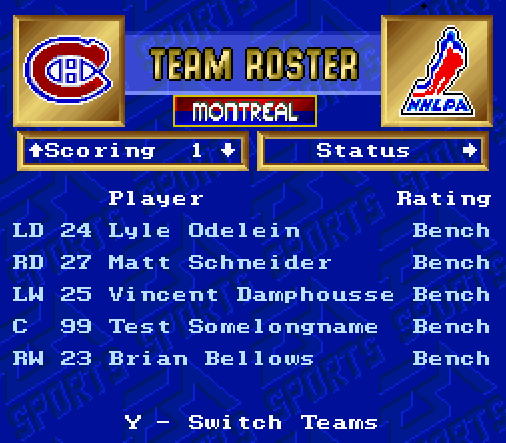
Enjoy
Download the editor here:
https://github.com/clandrew/nhl94e/releases/tag/v1.0
Or, find the editor source code here
https://github.com/clandrew/nhl94e
Find this post, in text form here:
https://raw.githubusercontent.com/clandrew/nhl94e/main/docs/PlayerNames.txt
This post explains Lagoon_hitbox.ips, a proof-of-concept patch created to enlarge the hitboxes in the game Lagoon for SNES. The patch was really quick+and+dirty. Nonetheless it's posted here:
http://secretplace.cml-a.com/edits.php
What follows is a description of the patch and how it works.
First, here are some useful memory locations
$01:0502-0503 - NASIR's X position in the map
$01:0504-0505 - NASIR's Y position in the map
$01:050A- The direction NASIR is facing.
- 00 means right
- 01 means down
- 02 means left
- 03 means up
$01:B710-B717 - The offsets of NASIR's hit box from his position, if he is facing right
$01:B718-B71F - The offsets of NASIR's hit box from his position, if he is facing down
$01:B720-B727 - The offsets of NASIR's hit box from his position, if he is facing left
$01:B728-B730 - The offsets of NASIR's hit box from his position, if he is facing upIn Lagoon, the following code is invoked whenever an action button is pressed, even if you're not near anything.
$01/9BBD AD 0A 05 LDA $050A ; A = the direction NASIR is facing.
;
$01/9BC0 0A ASL A ; A *= 8
$01/9BC1 0A ASL A ;
$01/9BC2 0A ASL A ;
$01/9BC3 18 CLC ;
$01/9BC4 69 20 ADC #$20 ; A += 0x20
;
; Now A effectively stores an array index with
; which to load hitbox offsets.
; If facing right: A = 0x20
; If facing down: A = 0x28
; If facing left: A = 0x30
; If facing up: A = 0x38
;
$01/9BC6 20 C3 B6 JSR $B6C3 ; Call CalculatePlayerHitboxDimensions()
$01/9BC9 60 RTS
The function CalculatePlayerHitboxDimensions() looks like the following
CalculatePlayerHitboxDimensions:
; Preconditions: A is set to one of
; {0x20, 0x28, 0x30, 0x38} depending on
; the direction NASIR is facing, as described
; above.
; Postconditions: $40, $42, $44, and $46 contain
; the dimensions of NASIR's hit box; left,
; right, top and bottom respectively.
$01/B6C3 C2 20 REP #$20
$01/B6C5 A8 TAY
$01/B6C6 AD 02 05 LDA $0502 ; Load NASIR's X position
$01/B6C9 18 CLC
$01/B6CA 79 F0 B6 ADC $B6F0,y ; Add left edge hitbox offset to NASIR's X position
$01/B6CD 85 40 STA $40 ; Store it as an output
;
$01/B6CF AD 02 05 LDA $0502 ; Load NASIR's X position
$01/B6D2 18 CLC
$01/B6D3 79 F2 B6 ADC $B6F2,y ; Add right edge hitbox offset to NASIR's X position
$01/B6D6 85 42 STA $42 ; Store it as an output
;
$01/B6D8 AD 04 05 LDA $0504 ; Load NASIR's Y position
$01/B6DB 18 CLC
$01/B6DC 79 F4 B6 ADC $B6F4,y ; Add top edge hitbox offset to NASIR's Y position
$01/B6DF 85 44 STA $44 ; Store it as an output
;
$01/B6E1 AD 04 05 LDA $0504 ; Load NASIR's Y position
$01/B6E4 18 CLC
$01/B6E5 79 F6 B6 ADC $B6F6,y ; Add bottom edge hitbox offset to NASIR's Y position
$01/B6E8 85 46 STA $46 ; Store it as an output
;
$01/B6EA 29 FF 00 AND #$00FF ; Clean up and return
$01/B6ED E2 20 SEP #$20
$01/B6EF 60 RTS If you were to skim the code quickly you'd see it loads hitbox dimensions from memory. From that, you might get the impression they are something dynamic. But, they come from a table hard-coded in ROM data. (you can see this based on the particular address they're loaded from).
Just so you know, the hitbox table data contains this (Semantics are left, right, top, bottom)
Facing Raw data Plain hex offsets Signed dec offsets
------ -------- ----------------- ------------------
Right 00 00 19 00 F8 FF 08 00 0h, 19h, FFF8h, 8h 0, 25, -8, 8
Down F0 FF 10 00 00 00 0F 00 FFF0h, 10h, 0h, 0Fh -16, 16, 0, 15
Left E7 FF 00 00 F8 FF 08 00 FFE7h, 0h, FFF8h, 8h -25, 0, -8, 8
Up F0 FF 10 00 F1 FF 00 00 FFF0h, 10h, FFF1h, 0h -16, 16, -15, 0 Yes, the game uses slightly differently-sized hitboxes depending on the direction you're facing.
Now, the patch. What this patch does is instead of offsetting NASIR's position by values from this table, it hacks it to offset the position simply by a hardcoded number. The hardcoded numbers yield bigger hitboxes than the offsets from the table.
It always applies the hitbox of offsets {-0x30, 0x32, -0x38, 0x30 } = {-48, 50, -56, 48 }. The hitbox size is 98x104 which is about 5 times bigger than the default.
The patch modifies just four operations in CalculatePlayerHitboxDimensions:
CalculatePlayerHitboxDimensions:
; Preconditions: A is set to one of {0x20, 0x28, 0x30, 0x38} depending on
; the direction NASIR is facing, as described above.
; Postconditions: $40, $42, $44, and $46 contain the dimensions of
; NASIR's hit box; left, right, top and bottom respectively.
$01/B6C3 C2 20 REP #$20
$01/B6C5 A8 TAY
$01/B6C6 AD 02 05 LDA $0502 ; Load NASIR's X position
$01/B6C9 18 CLC
$01/B6CA E9 30 00 SBC #$0030 ; Apply left edge hitbox offset -30h
$01/B6CD 85 40 STA $40 ; Store it as an output
;
$01/B6CF AD 02 05 LDA $0502 ; Load NASIR's X position
$01/B6D2 18 CLC
$01/B6D3 69 32 00 ADC #$0032 ; Apply left edge hitbox offset 32h
$01/B6D6 85 42 STA $42 ; Store it as an output
;
$01/B6D8 AD 04 05 LDA $0504 ; Load NASIR's Y position
$01/B6DB 18 CLC
$01/B6DC E9 38 00 SBC #$0038 ; Apply left edge hitbox offset -38h
$01/B6DF 85 44 STA $44 ; Store it as an output
;
$01/B6E1 AD 04 05 LDA $0504 ; Load NASIR's Y position
$01/B6E4 18 CLC
$01/B6E5 69 30 00 ADC #$0030 ; Apply left edge hitbox offset 30h
$01/B6E8 85 46 STA $46 ; Store it as an output
;
$01/B6EA 29 FF 00 AND #$00FF ; Clean up and return
$01/B6ED E2 20 SEP #$20
$01/B6EF 60 RTS And there you have it, the code for the proof-of-concept posted at the link above.
Here is a small improvement that can be made to the above hack. First, it'd be cleaner to modify the hitbox region offsets in the ROM directly. So let's do that instead.
To re-iterate, the default values are (with semantics left, right, top, bottom)-
Facing Raw data Plain hex offsets Signed dec offsets
------ -------- ----------------- ------------------
Right 00 00 19 00 F8 FF 08 00 0h, 19h, FFF8h, 8h 0, 25, -8, 8
Down F0 FF 10 00 00 00 0F 00 FFF0h, 10h, 0h, 0Fh -16, 16, 0, 15
Left E7 FF 00 00 F8 FF 08 00 FFE7h, 0h, FFF8h, 8h -25, 0, -8, 8
Up F0 FF 10 00 F1 FF 00 00 FFF0h, 10h, FFF1h, 0h -16, 16, -15, 0 The ROM file offsets for each direction are
Facing Headerless ROM file offset
------ --------------------------
Right B710
Down B718
Left B720
Up B728While we can patch the table manually, it makes for easier testing of changes if you use a patching program.
Here's some C++ code for one:
enum Direction
{
FacingRight = 0,
FacingDown = 1,
FacingLeft = 2,
FacingUp = 3
};
struct HitboxDir
{
int Left;
int Right;
int Top;
int Bottom;
};
void PushValue(int b, std::vector<unsigned char>* out)
{
if (b >= 0)
{
assert(b < 256);
out->push_back(b); // little endian
out->push_back(0);
}
else
{
int u = 0x10000 + b;
int low = u & 0xFF;
out->push_back(low);
u >>= 8;
assert(u < 256);
int high = u & 0xFF;
out->push_back(high);
}
}
int main()
{
FILE* pB = nullptr;
fopen_s(&pB, "Lagoon.hitbox.v2.smc", "rb");
// Check size
fseek(pB, 0, SEEK_END);
long sizeB = ftell(pB);
fseek(pB, 0, SEEK_SET);
std::vector<unsigned char> dataB;
dataB.resize(sizeB);
fread(dataB.data(), 1, sizeB, pB);
fclose(pB);
HitboxDir allDirs[] =
{
{0, 25, -8, 8},
{-16, 16, 0, 15},
{-25, 0, -8, 8},
{-16, 16, -15, 0}
};
// Enlarge hitboxes
int ff = 3;
int hf = 2;
allDirs[FacingRight].Right *= ff;
allDirs[FacingRight].Top *= hf;
allDirs[FacingRight].Bottom *= hf;
allDirs[FacingDown].Bottom *= ff;
allDirs[FacingDown].Left *= hf;
allDirs[FacingDown].Right *= hf;
allDirs[FacingLeft].Left *= ff;
allDirs[FacingLeft].Top *= hf;
allDirs[FacingLeft].Bottom *= hf;
allDirs[FacingUp].Top *= ff;
allDirs[FacingUp].Left *= hf;
allDirs[FacingUp].Right *= hf;
// Transfer hitbox info into byte data
std::vector<unsigned char> hitboxBytes;
for (int i = 0; i < 4; ++i)
{
PushValue(allDirs[i].Left, &hitboxBytes);
PushValue(allDirs[i].Right, &hitboxBytes);
PushValue(allDirs[i].Top, &hitboxBytes);
PushValue(allDirs[i].Bottom, &hitboxBytes);
}
// Patch the new tables in
int destOffset = 0xB710;
for (size_t i = 0; i < hitboxBytes.size(); ++i)
{
dataB[destOffset + i] = hitboxBytes[i];
}
fopen_s(&pB, "Lagoon.hitbox.v3.smc", "wb");
fwrite(dataB.data(), 1, dataB.size(), pB);
fclose(pB);
}Running this patching program yields the table
Facing Raw data Plain hex offsets Signed dec offsets
------ -------- ----------------- ------------------
Right 00 00 4B 00 F0 FF 10 00 0h, 4Bh, FFF0h, 10h 0, 75, -16, 16
Down E0 FF 20 00 00 00 2D 00 FFE0h, 20h, 0, 2Dh -32, 32, 0, 45
Left B5 FF 00 00 F0 FF 10 00 FFB5h, 0h, FFF0h, 10h -75, 0, -16, 16
Up E0 FF 20 00 D3 FF 00 00 FFE0h, 20h, FFD3, 0h -32, 32, -45, 0 Find a convenient, buildable version of patcher here: https://github.com/clandrew/lagoonhitbox/
You can use the patcher to change the hitboxes as you want. If this concept seems useful then it'd be a good idea to fuss with the values until they yield something desirable.
Note:
- All ROM file offsets are on headerless ROMs.
- The hitboxes calculated from the routine described here is used for both talking to NPCs, and combat. While there might be a motive to affect only combat, there've also been complaints that the hitboxes when talking to NPCs are too fussy, so YMMV.
- If you make the hitboxes obscenely large it can make the game hard to play. For example, if NPCs A and B are standing close to each other, attempting to talk to A might acidentally cause conversation with B.
This post is also available in text form here:
https://raw.githubusercontent.com/clandrew/lagoonhitbox/master/lagoon_patch_info.txt
See a video of it here: https://www.youtube.com/watch?v=lmg9sN9FO-w
Also on Twitter: https://twitter.com/clandrew__/status/1288941082202390533
As a fun thing to do for a few days I made this demo, for background I have programmed on Apple II in the past but in higher-level ways, through BASIC and Logo. The idea here was to write something in 6502 so that I could learn more about the platform. Prior to this I had some background debugging and doing small code patchings in SNES's 65816 (similar to 6502) and how to use an Apple II computer but no experience at all writing 6502 for it.
I got a book "Assembly Lines" by Roger Wagner which was a lot of help plus "Inside the Apple IIe" by Gary Little. And also a bigger book of opcodes lent to me by a friend.
Things that were easy
- Trancoding from a .PNG image file on Windows to indexed image data compatible with LORES memory layout. I wrote this command line tool which inputs an image file on Windows and outputs a bunch of data directives for the LORES compatible image data. I referred to the "Inside the Apple IIe" book to source out what the format is. The tool uses WIC to open the image and shoves a bunch of things around. This took like 20min. The code is here
https://github.com/clandrew/demoII/blob/master/ImageTranscoder/ImageTranscoder.cpp
- Testing on real actual hardware. What I mean is, I thought this would shake loose a bunch of problems. Especially around sound. There was conflicting information as to how you're supposed to access $C030 to sound the speaker. If an opcode technically corresponds to *two* accesses of the I/O port instead of one it could cancel out so no sound. This is an area where emulator would likely be more forgiving. And before you think "just copy from some sample code", various sample code and documentation contradicted each other. In the end I picked absolute LDA and it worked.
- Modern IDE Now, the bulk of the code was written using Merlin's interface on the actual Apple II. It's actually pretty good and I thought it was fine. Once in a while, whenever there was a big messy refactor though I copied the code out of the Apple II data disk and into a Windows filesystem text file because of course that's a thing. And quickly do the reverse, too. What a time to be alive.
- Debugging. The debugger built into the emulator is the most luxurious type of pampering. This is the reason I don't know what it is to work or to suffer. You can set breakpoints, conditional breakpoints, view memory and disassembly of what's executing. From talking to people, "Back in the day" you would debug by breaking into the Monitor or not at all. There are hobbyists writing Apple II code today though and I am pretty sure they all use tools like this. I feel okay with this hybrid way of doing things.
Things that were not easy
- Correct sound. Sound on most Apple II models is emitted in a weird way. You touch a memory-mapped I/O port- and how *frequently* you access the port (read or write) changes the pitch of the sound. A touch followed by 50 NOPs is a different pitch from a touch followed by 100 NOPs. And of course, you should put all of that in a loop or else the sound will be so quick it's hardly observable. You need very careful counting of clock cycles to play different tones of uniform duration. Yes, calculation involving clock cycles to figure out how to emit notes of *different tones* but *equal length*
- "Holes" and nonlinearity of graphics memory-map. Say you have some image data. It is stored with the top left byte first, and the bottom right byte last. To display it you might think, "just do a memcopy!". No no no. In graphics memory rows of pixels are stored in all jumbled up order. Even if you store your image data in that same jumbled-up order, there are "holes" in the range which you are not supposed to write to. Because I wanted to keep image positionings flexible for future use I had my source image data stored in straightforward order and copied each pair of rows based on a table of offsets. This wasn't the absolute worst just fussy.
- Branch distance limit. Because only one signed byte specifies the offset you can't branch anywhere too far away. To get around this, you branch to an intermediate place which jumps to the final place but also need to take care that the jump isn't accidentally taken by something else.
- Asymmetry of how you're allowed to use registers X and Y. For example, when you use indirect-indexed-load with X, it's pre-indexed but if you do it with Y it's post-indexed. Merlin's semantics between these two is ever so slightly different it's easy to miss and this was the root cause of an annoying bug I fixed Tuesday.
I scoped this project to LORES only so that it would be feasible and also a way to get comfortable with environment, instruction set and functions specific to this computer. The things I've heard about HIRES is that it's fewer colors, higher res, and more gnarly to work with, could also be good to check out at some point.
Some highlights
<-- Graphics bug turned a bit a e s t h e t i c.
The root cause of this was the image loading code would scramble the input image offset passed to it. I was testing out scrolling of images (as a possible future thing to add), so the corruption happened when you hit the "down" key. Scrolling would call the image loading code again with the scrambled registers, loading an image from an incorrect place and changing which incorrect place every time.

Debugger built into the emulator. does you a favor and gives memory-mapped registers helpful human readable names (e.g., SPKR, called CHIRP in my code) rather than raw offsets. This was how I sometimes found out that I was actually using some areas of memory which seem general purpose but are not really.

For the music, I sketched it out a single-channel MIDI in Noteworthy Composer and then started testing different tones to find what ratio of I/O port setting + busy waits would produce which notes. I added the frequencies as text in the staff at the bottom.
You have this problem of "how to emit tones of different pitch but the same duration".
This problem will be obvious to you if you've programmed Apple II like this before, but I'll say it in case: to emit a tone on Apple II you touch a memory-mapped IO port. How often you touch it determines what tone it is. "Touch" here means read or write.
You're going to want to touch the port in a loop padded with a bunch of sleeps. To get a lower note, add more sleeps. To get a higher note, use less sleeps*. Easy enough.
*For sleeps it doesn't literally have to be a sleep, it could be a NOP or anything that takes up time. In my sound code the busy wait is "decrement a counter, branch conditional". You could expand the gamut of what sounds you can emit by adding an actual NOP or two.
What if you want to emit two different tones which both have the same duration? If you change the number of sleeps, you change the duration. How fussy. Fortunately, we own the code for touching the port. So I fix this by counting the number of clock cycles it takes to emit a baseline tone, and solving for the number of sleeps needed to emit a different tone with the same duration.
My code to emit sound looks like
* ;CLOCK
A6 07 TONE LDX $07 ;3
A4 06 DUR LDY $06 ;3
AD 30 C0 LDA CHIRP ;4
88 PCH DEY ;2
D0 FD BNE PCH ;Branch taken: 3. Not taken: 2
CA DEX ;2
D0 F5 BNE DUR ;Branch taken: 3. Not taken: 2
60 RTS ;6See there is a routine called TONE, and two loops labeled DUR and PCH.
PCH is an inner loop.
DUR is an outer loop.
I added comments describing how many clock cycles each line will take. For branches the number of clock cycles depends on whether the branch is taken.
Example of usage of TONE- (this part doesn't vary between pitch
or duration so clocks are not taken into account)
A9 BC LDA #188
85 06 STA $06
A9 6A LDA #106
85 07 STA $07
20 26 66 JSR TONE
60 RTS TONE is subroutine with two arguments: pitch and duration, nicknamed pch and dur below.
TONE takes some number of clock cycles to execute, nicknamed clk below.
We can calculate clk as a function of pch and dur.
Looking at the implementation of TONE, the initial load and return don't vary so they weren't taken into consideration. But we can go line by line and calculate how many clock cycles the interesting parts will be
clk = 0;
clk += dur * 3; // DUR LDY $06
clk += dur * 4; // LDA CHIRP
clk += pch * dur * 2; // PCH DEY
clk += (pch * dur * 3) - (dur * 3); // BNE PCH (branch taken)
clk += dur * 2; // BNE PCH (branch not taken)
clk += dur * 2; // DEX
clk += (dur * 3) - 3; // BNE DUR (branch taken)
clk += 2; // BNE DUR (branch not taken)which simplifies down to
clk = dur * (11 + 5 * pch) - 1;rearranged to solve for dur, you get
clk + 1 = dur * (11 + 5 * pch)
dur = (clk + 1) / (11 + 5 * pch)This way I got what value of 'dur' you need for each pitch to use to get about the same target cycle count as the middle pitch, 138 with duration 144 (picked arbitrarily).
If you are pro you might factor non-sound code (e.g., the loading of graphics images) into your calculations.. fortunately here the amount of time to load graphics and on other control flow ended up being negligible so it didn't end up mattering
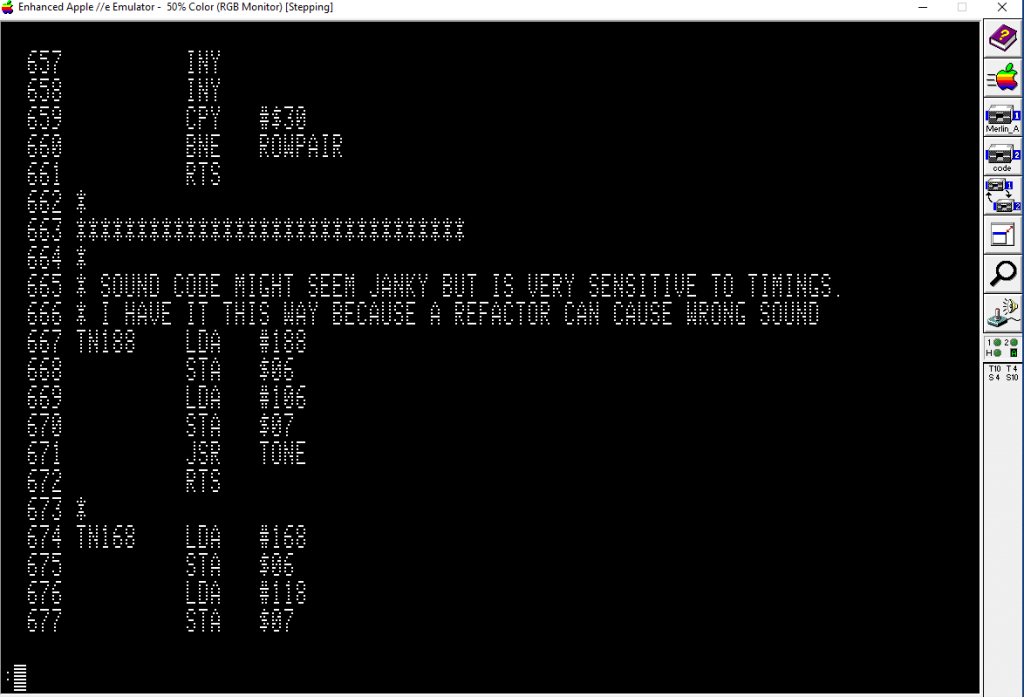
And of course, a good thumbnail is about setting the right expectation.
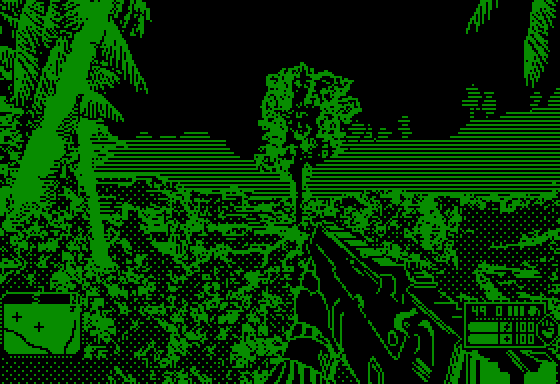
Source code posted here: https://github.com/clandrew/demoII/blob/master/T.GR.asm
Finished Arcana (SNES).
Play as Rooks, an orphaned magic card user who needs to stop an evil empress vying to take over the kingdom. Rooks also wants to live up to his late father's legacy.
Turn-based JRPG, Wizardry-like, with "cards" being a prominent visual motif and somewhat gameplay motif. Unique qualities: no backtracking, death of anyone in your party == game over
The use of cards in the gameplay would lead you to think the game has a combat system way more evolved than the old "Fight Magic Item Flee". It does not.
There is a rock-paper-scissors-style elemental system. The game is balanced such that you can ignore it. There are also four pokemon ("Spirits") which act like party members except disposable and only their magic is any good.
Pop quiz: magic spell called "Attribute 6". What does it do, take a guess? Bonus: how it is different from Attribute 5.
I think people might not play this game any more because of the enemy system. What enemy system? Random encounters. How many? A lot. It has one of the worst grinds. Find enclosed: random encounters every two steps in the map, or on simply a 90 degree turn. If not for the in-game map it would have been a big problem. Although there's items and spells to hightail it out of a dungeon, you always enter a dungeon from the very beginning.
Lack of checkpointing is a problem for one of the largest areas called "Stavery Tower", a twelve-floor maze. You can't save while in a dungeon, not even a save-to-be-deleted-on-resume (those are not popular on SNES platform anyway). So you will need to book one to three hours per game session. Alternatively, you can leave your SNES on and hope there isn't a power outage, or use a piece of technology which rhymes with asdflemulator.
Still, the first 5 minutes and the last 30 minutes were Awesome. This game has a great soundtrack and visual style with a lot of character. The final boss concept is extremely cool. This game, you can tell what they were going for.
